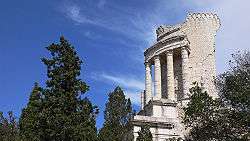Tropaeum Alpium
The Tropaeum Alpium (Latin 'Trophy of the Alps', French: Trophée des Alpes), is a Roman trophy (tropaeum) celebrating the emperor Augustus's decisive victory over the tribes who populated the Alps. The monument's ruins are in La Turbie (France), a few kilometers from the Principality of Monaco.

Construction
The Trophy was built c. 6 BC in honor of Augustus to celebrate his definitive victory over the 45 tribes who populated the Alps. The Alpine populations were defeated during the military campaign to subdue the Alps conducted by the Romans between 16 and 7 BC.
The monument was built of stone from the Roman quarry located about 800 metres away, where traces of sections of carved columns are visible in the stone.
The monument as partially restored is 35 meters high. When built, according to the architect, the base measured 35 meters in length, the first platform 12 meters in height, and the rotunda of 24 columns with its statue of an enthroned Augustus is 49 metres high.
Inscription
One of the stones of the tower, which Pliny the Elder transcribed,[1] contained the names of the tribes. It reads:
To the emperor Caesar Augustus, son of the deified [Julius Caesar], Pontifex Maximus, hailed as Imperator[2] for the 14th time, in his 17th year of tribunician power,[3] the Senate and people of Rome [built this], in commemoration that, under his leadership and auspices, all the Alpine peoples, from the Upper Sea to the Lower Sea, were submitted to the Imperium[4] of the Roman People. Conquered Alpine peoples:[5]
|
· TRUMPILINI |
· VINDELICI: |
· LEPONTII |
· BRIGIANI |
· ECDINI |
Later life
The monument originally served no military purpose and contained no fortress. Rather, it marked the boundary between Italy and Gallia Narbonensis, later pushed back to the Var River. Between the 12th and 15th centuries, however, the Trophy did become a fortress, with locals building houses around its walls. In 1705, when war broke out between Savoy and France during the War of the Spanish Succession, Louis XIV ordered the destruction of all fortresses in the region, including this one. The partially destroyed Trophy then became a quarry and its stones were used, among other things, to build the nearby church of Saint-Michel.
The monument was partially restored in 1929 with funds from American philanthropist Edward Tuck.[6]
Nearby Roman remains
The Trophy is situated on the Via Julia Augusta, named after Augustus, a continuation of the Via Aurelia which linked Vintimille to Cimiez (Nice). Various fountains within the territory of the communes of Beausoleil and Roquebrune-Cap-Martin are also said to be Roman.
Museums
The Edward Tuck Museum on the site of the Trophy includes fragments, plaster molds, old photographs documenting the monument and its reconstruction. It was built in 1929 and renovated in 2011.[6]
It also includes a 1:20 scale model of the reconstructed Trophy. Another 1:20 scale model is found in Room IX of the Museo della Civiltà Romana in Rome.[7]
References
- Pliny the Elder, Naturalis Historia, book III, 24.
- Commander-in-chief.
- Dating the monument to 6 or 7 BCE
- Sovereignty.
- CIL V, 07817 =AE 1973, 323: Original Latin reads - IMP · CAESARI DIVI FILIO AVG · PONT · MAX · IMP · XIIII · TR · POT · XVII · S · P · Q · R · QVOD EIVS DVCTV AVSPICIISQVE GENTES ALPINAE OMNES QVAE A MARI SVPERO AD INFERVM PERTINEBANT SVB IMPERIVM P · R · SVNT REDACTAE · GENTES ALPINAE DEVICTAE :
- Visitor information card (in French)
- "Room XI: Augustus", Museo della Civiltà Romana
See also
External links
| Wikimedia Commons has media related to Tropaeum Alpium. |